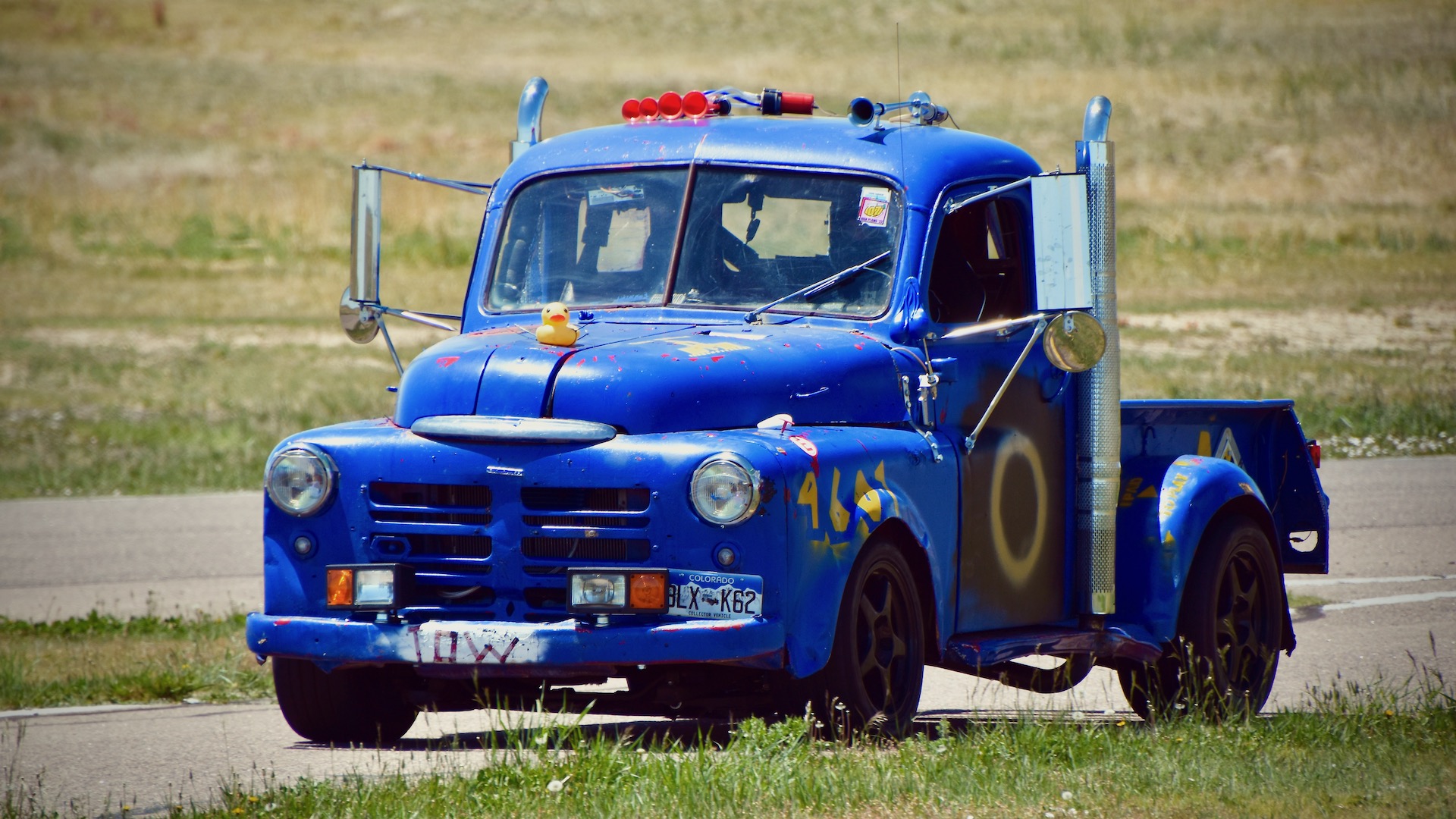We may earn revenue from the products available on this page and participate in affiliate programs. Learn more ›
It doesn’t matter whether it’s trackworthy, or barely able to turn a corner: It’s welcome at the 24 Hours of Lemons. Somehow, the 1950 Dodge B-Series pickup of over-the-road trucker Kevin Temmer belongs near both ends of that spectrum. With parts from at least nine different cars, it’s truly one-of-a-kind, and not in the way that Bring a Trailer bidders like.
By no means should it be any good on a racetrack. And yet it is, kind of, in its own way. Deep down, beneath the corners taken on two wheels and one-wheel peels, is an exceptional race truck itching to break free. And one day, I think it might.

1950 Dodge B-Series Race Truck Specs
- Powertrain: 5.9-liter V8 | 6-speed manual | rear-wheel drive
- Horsepower: 230 (estimated)
- Torque: 350 lb-ft (estimated)
- Curb weight: 3,600 pounds (estimated)
- Provenance: Index of Effluency, Heroic Fix, and I Got Screwed in the 24 Hours of Lemons
- Quick take: A 72-year-old pickup that corners like a Miata will break your brain.






Temmer’s truck is easily among the most famous (infamous?) of Lemons cars for a reason. The former farm truck had been acquired basically for free in sketchy shape, and raced until its worn-out flathead six from a 1937 Plymouth blew. Then he replaced it trackside, with another extracted from a retired airport tug. It’s plated and smogged, so he’s driven it to and from races numerous times—though not without consequence. The flywheel once fell off right at the track’s gate, and he had to reattach it in the paddock so he could get home. Which he did, after racing the truck half the weekend regardless.
That replacement engine eventually let go, and when it did, Temmer started thinking bigger. We’re talking a 5.9-liter Magnum V8 crate motor, easily the single priciest piece of the whole truck. It’s backed by a six-speed manual from a Ram 2500, which propels the rear axle from a Jaguar XJ6. It’s complete with inboard disc brakes and independent suspension, with trailing arms from a Lexus LS400. The front suspension is XJ6 too, though don’t ask me about the “spring compressor” he used to make those coily boys fit.
The wheels and tires come from a C4 Corvette ZR1, while the power steering is from a Toyota Mirai. Yes, the hydrogen car. They found one in a junkyard in Colorado, and installed its steering system at the track when the old Cadillac-sourced column failed. I’m still as incredulous as you probably are, and I watched them do it.
Being a race truck, it doesn’t have much of an interior, but what’s left is just as slapdash as the rest of the truck. The transmission doghouse is cut from the roof of a Lincoln that Temmer and another racer turned into a hot tub, the dash is made of a Dodge Neon hood, and the shift boot is Datsun in origin. Its passenger seat is mounted on a steely from a 1965 Plymouth Valiant—nothing says safety like Mopar.




Based on that list of parts, you’re probably thinking that this truck drives like an absolute mess. It doesn’t, though it’s not what I’d call easy to drive. What the build sheet doesn’t tell you is how awkward the pedal box is—the doghouse offsets the accelerator to the left of the steering column. It’s pretty high up, so you have to hover your foot to use it, and switching to the brakes or clutch requires looking down to find them.
The shifter was even more cryptic, with a lever so long that I could swear the transmission was in another car. Throws felt feet long, and finding the right gear required multiple tries. It got better after Temmer hacked a foot off of it during a pit stop, but I still found it easier to just leave the truck in fifth for the whole track.
That’s not as unpleasant as it sounds when you’ve got 5.9 liters worth of torque, and a final drive like a rally car. Even out of hairpins, it still had the torque to make the open diff smoke the inside rear, a massive 335-section Michelin Pilot Super Sport. It and the inside front could both come off the ground in hard corners, the sway bar not quite being as stiff as would be ideal.



All this probably gives you the impression this truck has no business being on a track. The club racer-spec Miatas and BMWs I gave point-bys probably thought so too—only to see its blue grille stay in their mirror down the straights, and into the corners up to the apex. There, its inability to put power down meant the gap widened, but on most of High Plains Raceway, it was as quick as almost any car it raced against. I’d go as far as saying it’s only a few mods from being highly competitive: A stiffer front sway bar, less tire, a rear LSD or locking differential, and maybe bigger brakes, and I think this ancient Dodge could be in the running for an overall win.
Whether it ever gets those upgrades is a big maybe, as Temmer has so far been content spending more of his race weekends fixing his truck than driving it. That’s a possibility any Lemons racer has to not just accept, but relish, and with how many times it has happened to Temmer, relish it he does. After all, if someone’s happy where they are, you can’t expect them to change—especially if they and their creations still bring light into others’ lives.

Got a tip or question for the author? You can reach them here: james@thedrive.com

